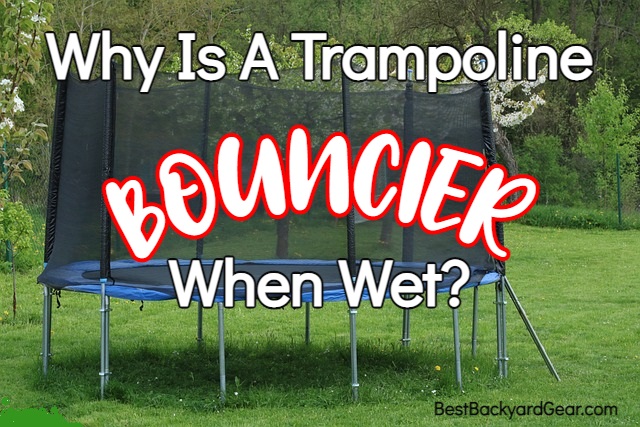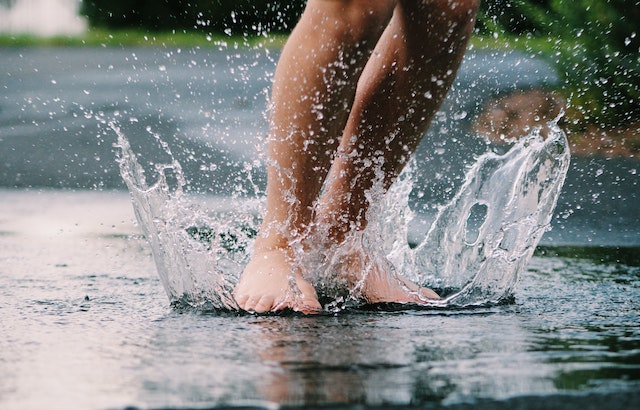Why Is A Trampoline Bouncier When Wet?
There’s something exhilarating about bouncing on a wet trampoline, isn’t there? Aside from the drops flying every which way, you feel like you’re soaring! Why is this? Have you ever wondered “why is a trampoline bouncier when it is wet”? Here’s your answer.
There are two simple theories as to why wet trampolines seem bouncier. 1) When you bounce on the wet mat, the water moves and cools the mat slightly. This makes the mat somewhat stiffer and less pliable than it is when it’s warm and dry, and it snaps you back with greater force. 2) The weight of the water on the mat is added to the weight of the jumper, making the downward force greater and the resulting “snap back” stronger and higher.

1. Two Possible Explanations
Water has a cooling effect on trampoline mats. This is pretty common knowledge. After all, I think it’d be safe to say that most of you reading this have at one point or another turned on the lawn sprinkler beside your kids’ trampoline to cool the hot black mat off on a warm summer day.
When the cool water on the trampoline mat is BOUNCED, the movement of the water on and through it causes quick cooling of the plastic fibers in the mat. And as a result, the mat grows slightly stiffer due to the cooling. And stiffer means less elasticity.
Now you’d think that you would want the mat to be MORE elastic, instead of less, right? But remember, the MAT is not what makes the trampoline bounce… it’s the SPRINGS. The mat is stretched between the springs, and when downward force is applied to the mat, the SPRINGS stretch. When the stretching reaches the max for that weight, the springs snap back, forcing the mat back into shape and the force of that person’s weight upwards. A stiff mat resists this more than a pliable one, and so the snap back is stronger. And the bounce is greater.
1.2. There's More Weight
This is a pretty simple explanation, given by some helpful folks over on Reddit. I thought it was spot on, so I’ll summarize it for you.
Water from rain or a lawn sprinkler simply adds weight to the jumper. And heavier jumpers bounce higher.

Adding water to the mat makes the mat heavier on the downward thrust. So the “snap back” or bounce into the air is bigger in response!
1.3. Or, Is It Just An Illusion?
I am not claiming that the two explanations given above are scientifically tested. They do make a lot of sense though, and work with the scientific principals behind them (for example, Newton’s Third Law Of Motion).

If you’ve ever jumped on a wet trampoline, you’ll know that they are slippery, and when you jump, what you see when you are “mid-slip” can fool you. Your brain expects the mat to be in a certain place, and when you experience a quick slip, suddenly you are seeing slightly “off” from your expectation! You think to yourself, “hey, I’m jumping higher” when really, you’re not… you’re jumping the same height, but are slightly to the left or right.
Is A Wet Trampoline Safe To Bounce On?
Wet trampolines are a lot of fun, and positioning a lawn sprinkler beside your backyard trampoline is a great way to encourage kids to bounce away the hot summer afternoon. But is a wet trampoline SAFE?
Unfortunately no. Dry trampolines cause fair bit of injuries (ask any ER nurse what the most popular cause of injuries are and I kid you not, trampolines will be in the top 3) – but WET trampolines cause even more, as they add a slippery element.
I’m not telling you NOT to let your kids bounce on a wet mat, but rather to make a point of reminding them to take a bit of extra care. Allowing less kids on at a time when the trampoline is slippery is preferable (if you can convince them to go with one at a time, do!). Making sure the trampoline safety net doorway is closed properly. And cautions about the heightened risks of rough-housing on a slippery base are important as well.
Can I Jump On The Trampoline When It's Raining?
Any chance of lightning and the trampoline should IMMEDIATELY be off limits until the treat has past. A wet trampoline mat can conduct electricity, and if lightning strikes near your trampoline, the jumpers will be at serious risk of electrocution.

Check Out This Video
There are backyard trampolines and there are super-trampolines like the ones the guys in this video are playing around with. They firmly believe that a wet trampoline gets a bigger, crazier bounce. Check out the fun when they wet a super-trampoline!
Does Water Wreck A Trampoline?
Backyard trampolines, from basic entry level ones to high capacity trampolines or backyard gymnastic trampolines, are intended to be set up and left up all season. So rest assured that they are designed to handle rain, and that water does not wreck them.
The trampoline mat, safety net enclosure, and frame are all made from materials that can handle getting wet.
The only area for even a small bit of concern is the springs. The pad that lays over the springs, besides protecting jumpers from getting caught in them, also acts as a protective layer keeping them (relatively) dry. The springs are the only part on most trampolines that could begin to rust if exposed to the elements a lot – and honestly, most of the better quality trampolines out there have addressed this issue by coating their springs in protective materials.
In Summary
Wet trampolines are a ton of fun, and send you slipping and soaring. The answer to the question of “why are trampolines bouncier when they are wet?” comes down to 2 main reasons, to summarize.
- A cooler, stiffer mat makes a faster snap back to its original position, bouncing the jumper higher.
- Water adds weight to the downward thrust of the jump, so it seems the jumper is heavier than he/she actually is. And to paraphrase Newton’s 3rd Law, a bigger action gets a bigger reaction.




